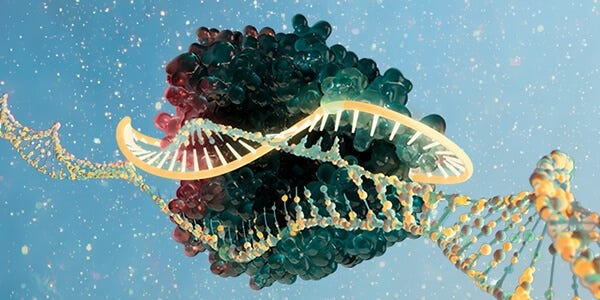Introduction to Genome Editing
The process of genome editing involves the use of custom engineered endonucleases, or “molecular scissors,” to accurately modify endogenous genomic DNA sequences. Engineered endonucleases most commonly consist of a customizable DNA binding domain (DBD) attached to a non-specific endonuclease, enabling double strand breaks (DSBs) to be introduced at specific genomic loci. DSBs are repaired by one of two cellular DNA repair mechanisms: non-homologous end joining (NHEJ) or homology-directed repair (HDR). Repair by NHEJ typically introduces small insertions or deletions (indels) potentially leading to a frameshift mutation and ultimately, a functional gene knockout. Precise nucleotide corrections, generation of reporter lines, and precise gene deletions or insertions are accomplished by co-delivery of an exogenous donor DNA template integrated by HDR (Choulika et al., 1995).
Development of the CRISPR/Cas9 (Clustered Regularly-Interspaced Short Palindromic Repeats/CRISPR Associated Protein 9) system has made genome editing more accessible to the wider scientific community (Mali et al., 2009). Originally derived from Streptococcus pyogenes, the system consists of Cas9 nuclease and a guide RNA (gRNA), containing either a single guide RNA (sgRNA) or the two-part CRISPR RNA (crRNA) and trans-activating crRNA (tracrRNA). The gRNA harbors a customizable sequence approximately 20 nt in length that guides Cas9 to the target sequence for the creation of a double-strand break. The relative ease of gRNA synthesis has established CRISPR/Cas9 as the genome editing tool of choice.
Off-target editing is currently a major concern within the genome editing field, with the specificity of the early systems in question. Modified versions of wild-type Cas9 are being developed to increase specificity. For example, a mutant form of Cas9 known as Cas9 nickase (Cas9D10A) can only create single-strand nicks at the specified target and does not initiate DNA repair (Chiang et al., 2016). When two complexes are targeted to opposite strands in close proximity, a double-strand break occurs, which initiates DNA repair. Cas9 nickase, as well as other improved methods, are paving the way for the use of CRISPR/Cas9 in future cell and gene therapies.
The relative ease of sgRNA synthesis has established CRISPR/Cas9 as the genome editing tool of choice, ahead of ZFNs and TALENs whose complex protein engineering has proved to be a stumbling block in achieving ease-of-use. However, specificity of the CRISPR/Cas9 system is frequently questioned. ZFNs and TALENs must dimerize in order for FokI nuclease activity to occur, making the DNA binding process highly specific. In contrast, Cas9 functions as a monomer, reducing sequence specificity and increasing the risk of encountering and cleaving “off-target” sequences in the genome. As a result, researchers have begun replacing Cas9 nuclease with Cas9 nickase which produces single strand breaks (SSBs) or ‘nicks’ rather than DSBs. When Cas9 nickase is employed as a pair, each cleaving one of two DNA strands at two adjacent sites, a DSB is introduced. This improved method for reducing off-target effects with the CRISPR/Cas9 system is paving the way for its use in future cell and gene therapies.
Key Publications
- Choulika et al. demonstrate induced homologous recombination in chromosomal DNA by the double-strand break repair mechanism in mammals using the mitochondrial intron-encoded endonuclease I-SceI of Saccharomyces cerevisiae.
Choulika A et al (1995) Induction of homologous recombination in mammalian chromosomes by using the I-SceI system of Saccharomyces cerevisiae. Mol Cell Biol 15(4): 1968-73. - Ding et al. compare the relative efficacies of CRISPRs and TALENs. They found that CRISPRs consistently and substantially outperformed TALENs in their system.
Ding Q et al. (2013) Enhanced efficiency of human pluripotent stem cell genome editing through replacing TALENs with CRISPRs. Cell Stem Cell 12(4): 393-4. - The authors report on the use of the CRISPR/Cas9 system for human genome engineering. The type II bacterial CRISPR system was modified to function with custom gRNA in human cells. This resulted in efficient and robust genome editing, as well as multiplex editing of target loci upon simultaneous addition of multiple gRNAs.
Mali P et al. (2013) RNA-guided human genome engineering via Cas9. Science 339(6121): 823-6.
On-Demand Webinars
Using CRISPR/Cas9 to Model Stem Cell Organization and Dynamics
View this webinar presentation by Dr. Ruwanthi Gunawardane, Director of Stem Cells and Gene Editing at the Allen Institute for Cell Science, who discussed the application of CRISPR/Cas9 to create a dynamic visual model of human induced pluripotent stem (hiPS) cell organization.

Allen Institute for Cell Science
- Creation of a dynamic visual model of hiPS cell organization through the endogenous labeling of major cellular organelles with a fluorescent protein
- Overview of the CRISPR/Cas9 methodologies used for endogenous gene tagging, screening for precise editing, and cell biological and genomic quality control
- An unprecedented clarity in live cell imaging provided by the endogenous tagging of hiPS cells
- Potential applications of the Allen Institute's hiPS cell lines for basic science and disease modeling
Allen Institute for Cell Science
Ruwanthi (Ru) Gunawardane, PhD, is the director of stem cells and gene editing at the Allen Institute for Cell Science, where a multi-disciplinary, team-science approach is used to study the fundamentals of cell behavior. Ru leads a group of researchers creating a collection of high-quality gene edited stem cell lines that are used by the institute to study cell organization and activities through live cell imaging and are also made available to the research community. Ru joined the Allen Institute after spending 5 years at Amgen, where she developed assays to screen for novel therapeutics in oncology, inflammation, and cardiovascular diseases and help advance the early drug discovery pipeline. Prior to Amgen, Ru worked at Ambit Biosciences as part of a small team of scientists that identified and characterized AC220, a potent FLT3 kinase inhibitor that is currently in phase 3 trials for AML. Ru obtained her PhD in Biology from Johns Hopkins University, where she studied microtubule nucleation in the Drosophila and Xenopus model systems. She conducted her postdoctoral work at the Harvard Medical School, where she studied cell migration and invasion in mammary epithelial cells using 3D tissue culture model systems as a model for breast cancer progression.
Investigating Metabolic Disease with Human Pluripotent Stem Cells
The ability of human pluripotent stem cells (hPSCs) to differentiate into the many specialized cell types of the human body holds great promise for the study and treatment of human disease. Genome editing of hPSCs can allow for more accurate modeling of human diseases by introducing disease-specific mutations or correcting genetic aberrations in patient-derived induced pluripotent stem cell lines. Advances in genetic tools, such as clustered regularly interspaced short palindromic repeat (CRISPR) technology, have improved the ease and efficiency of genome editing in hPSCs.
View this webinar presentation by Dr. Chad Cowan, who discussed his research efforts to understand metabolic disease using the CRISPR/Cas system in human pluripotent stem cells to create genetic disease models.

Harvard University, Cambridge, MA
- Culture conditions for expansion and cloning of hPSCs
- Design and use of TALENs or CRISPRs with hPSCs
- Applications of modified hPSCs in modeling metabolic disease
- Differentiation of hepatocyte-like cells
- Differentiation and chemical conversion of white to brown adipocytes
Harvard University
Dr. Chad Cowan obtained his PhD from the University of Texas Southwestern at Dallas and continued on to complete a postdoctoral fellowship in the lab of Dr. Douglas Melton at Harvard University. Currently, he is an Associate Professor at Harvard University in the Department of Stem Cell and Regenerative Biology and Massachusetts General Hospital, with appointments in the Center for Regenerative Medicine, Cardiovascular Research Center, and Center for Human Genetics Research. He is also an Associate Member of the Broad Institute and a Principal Faculty member of the Harvard Stem Cell Institute, where he directs the Diabetes Disease Program and the iPS Cell Core Facility. Chad uses genome editing to introduce disease-associated gene mutations into hPSCs and differentiates these cells into relevant tissue types to develop ex vivo disease models and for genetic and drug screens.
Genome Editing - From Modeling Disease to Novel Therapeutics
Human pluripotent stem cells (hPSCs) hold great promise for the study and treatment of human disease owing to their ability to differentiate into many specialized cell types of the human body. The use of genome editing tools to generate specific DNA variants in hPSCs, by either introducing disease-specific mutations or correcting genetic aberrations, provide more accurate modeling of human disease when differentiated into human-derived tissues. Advances in genetic tools, such as transcription activator-like effector nucleases (TALENs) or clustered regularly interspaced short palindromic repeat (CRISPR) technologies, have improved the ease and efficiency of genome editing in hPSCs.

Harvard University, Cambridge, MA
- Culture conditions for expansion and cloning of hPSCs
- Design and use of TALENs or CRISPRs with hPSCs
- Identification of clones without antibiotic selection
- Applications of modified hPSCs including disease modeling
- Use of the CRISPR/Cas system for gene therapy
Harvard University
Dr. Chad Cowan obtained his PhD from the University of Texas Southwestern at Dallas and continued on to complete a postdoctoral fellowship in the lab of Dr. Douglas Melton at Harvard University. Currently, he is an Associate Professor at Harvard University in the Department of Stem Cell and Regenerative Biology and at Massachusetts General Hospital. He is also an associate member of the Broad Institute and a principal faculty member of the Harvard Stem Cell Institute, where he directs the Diabetes Disease Program and the iPS Cell Core Facility. Chad uses genome editing to introduce disease-associated gene mutations into hPSCs and differentiates these cells into relevant tissue types to develop ex vivo disease models and for genetic and drug screens.
Tools for Genome Editing
Genome Editing Precision for Cell Biologists
The ArciTect™ family of products for CRISPR-Cas9 genome editing provides you with a rapid, flexible, and precise system to modify the genome as you see fit. The single guide RNA (sgRNA) or the CRISPR RNA (crRNA) can be designed and ordered using our CRISPR Design Tool. The ArciTect™ product family has been optimized for high-efficiency genome editing of stem and primary cell types, including human embryonic stem (hES), human induced pluripotent stem (hiPSC), primary human T cells, and CD34+ hematopoietic stem and progenitor cells (HSPCs).
- ArciTect™ sgRNA: Custom-designed sgRNA containing the crRNA and tracrRNA regions within a single molecule
- ArciTect™ crRNA: Custom-designed CRISPR RNA for guide RNA generation in CRISPR-Cas9 genome editing
- ArciTect™ tracrRNA Kit: Trans-activating crRNA for guide RNA generation in CRISPR-Cas9 genome editing
- ArciTect™ Cas9 Nuclease: Cas9 nuclease for the generation of double-strand breaks in CRISPR-Cas9 genome editing
- ArciTect™ Cas9-eGFP Nuclease: Enhanced green fluorescent protein (eGFP)-tagged Cas9 nuclease for the generation of double-strand breaks in CRISPR-Cas9 genome editing
- ArciTect™ Cas9 Nickase: Modified Cas9 nuclease for the generation of single-strand breaks in CRISPR-Cas9 genome editing
- ArciTect™ Human HPRT Positive Control Kit: Positive control for CRISPR-Cas9 genome editing
- Annealing Buffer (5X): For guide RNA generation in CRISPR-Cas9 genome editing

